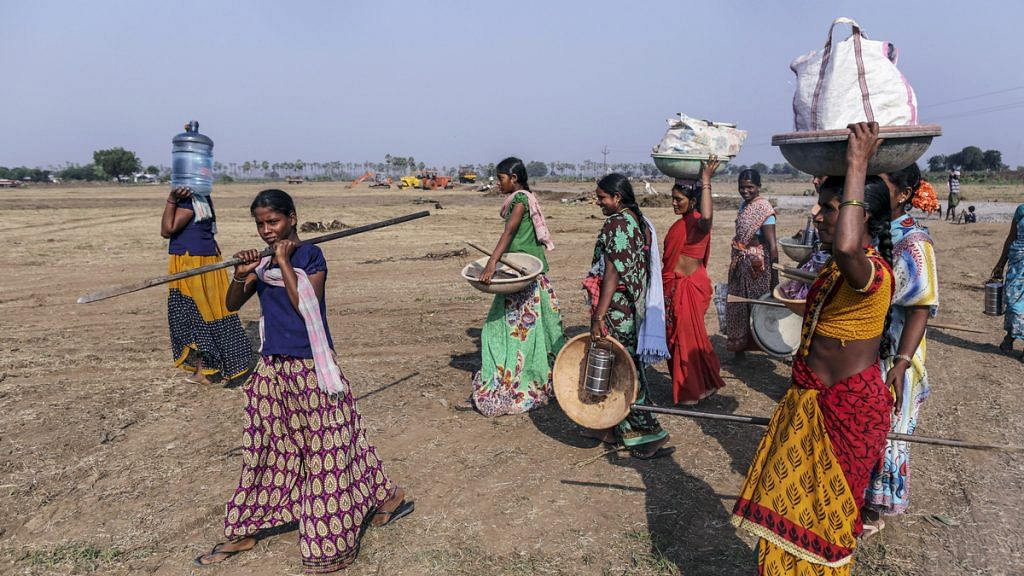New Delhi: States won’t find it easy now to knock the central government’s door to get their budgets enhanced for the rural job scheme under the Mahatma Gandhi National Rural Employment Guarantee Act (MNREGA).
Concerned over states’ low spending in creation of durable, good quality material assets under the scheme vis-à-vis the wage expenditure, the Narendra Modi government has decided to tighten the review of states’ expenditure to ensure they strictly follow the 60:40 ratio.
The 2005 Act — which provides for at least 100 days of annual wage employment to one adult member of every rural household — mandates that while 60 per cent of the total expenditure under MNREGA has to be on wage, 40 per cent spending has to be on the creation of material assets.
This ratio has been fixed to ensure the creation of productive assets of prescribed quality and durability. However, states don’t adhere to it currently.
“As a result, the average wage material ratio has been loaded in favour of wage expenditure while the expenditure on the material component has been on the lower side,” said a source in the Union Ministry of Rural Development.
To tackle this, the ministry will now mandate a rigorous internal audit on a monthly and six-monthly basis. Under the audit, states will have to provide detailed information on the asset created, whether it’s new or an upgrade of existing infrastructure, pre- and post-estimate of work carried out, progress at any given point of time against the sanctioned budget, and generation of muster rolls, among others.
“Whether a state’s outlay will be enhanced or not will depend on whether they fulfill these criteria,” said the source.
In Union Budget 2020-21, the rural employment scheme allocation was slashed to Rs 61,500 crore from Rs 75,000 crore (2019-20 revised estimates).
According to data provided by the rural development ministry, the average national wage paid on a per-day per-person basis was Rs 182 in 2018-19 — up 17 per cent from 2014-15.
Also read: To meet fiscal deficit target, Sitharaman’s Budget leaves out some expenditure
Why the govt will monitor
A government official familiar with the matter told ThePrint that the rural development ministry decided on stringent monitoring following criticism from several quarters that MNREGA hasn’t helped create durable assets despite massive spending to secure the livelihood of rural unemployed.
According to the data provided, the national average wage-material ratio was 73.31 per cent and 26.69 per cent in 2013-14. The corresponding figures for 2014-15 were 72.43 per cent and 27.57 per cent.
In both those fiscals, only three states — Bihar, Jammu and Kashmir and Sikkim — had a material expenditure of 40 per cent or more.
Kerala and Tamil Nadu were among the worst performers. While the former had a material expenditure of just 3.02 per cent in 2013-14, Tamil Nadu spent 2.22 per cent. The figures improved only marginally in 2014-15, with Kerala spending 3.14 per cent and Tamil Nadu 9 per cent.
The situation improved slightly in 2017-18 and 2018-19, but even then states spent 70.41 per cent and 70.78 per cent, on an average, on wages, and only 29.59 per cent and 29.22 per cent on material assets, respectively.
The material assets created under the scheme include water conservation and water harvesting structures to augment and improve groundwater, micro and minor irrigation works and creation, renovation and maintenance of irrigation canals and drains, renovation of traditional water bodies, land development works in common land, among others.
How the government plans to do it
According to the source quoted above, “The ministry is now strengthening the internal audit to ensure greater rigour and discipline by states, besides a two-layer monitoring of the whole process starting at the district level.”
Under this, the state programme managers will do a monthly review to ensure that states are adhering to the 60:40 rule. This will then be reviewed by the Union ministry.
While the ministry did conduct internal audits earlier, the practice was “not rigorous”. “There was limited number of internal audits because of lack of manpower both at the central and state level to conduct monthly audits,” said the source.
The ministry is now strengthening the system of internal audit by creating a large group of trained internal auditors. “They will be divided into state resource persons, district resource persons and village resource persons. This will ensure monitoring at every level,” a second source added.
The ministry has already started training state resource persons to conduct the audit and other rural development schemes at the Hyderabad-based National Institute of Rural Development and Panchayati Raj.
“The ministry will gauge the performance of each of the states on a monthly and six-monthly basis and will then take a call on releasing the budget to the respective states,” said the source.
Besides, the ministry will also get an automatic system-generated alert for the concerned states through the in-house software developed for this purpose. The alert will go to the respective MNREGA commissioner, who will then have to find out the reasons for the low spending.
Also read: IAS and IRS officers in the finance ministry don’t really retire in Modi govt
